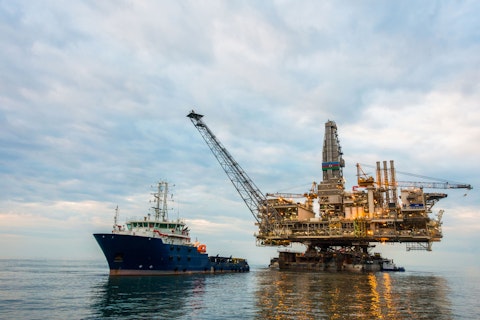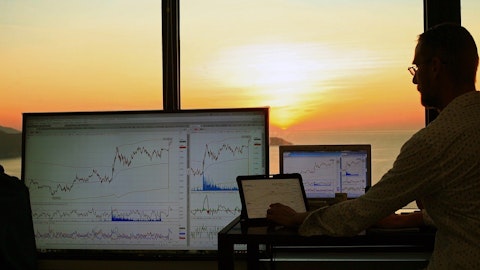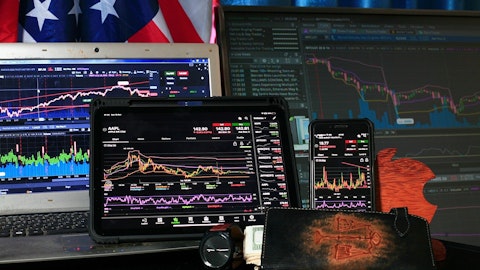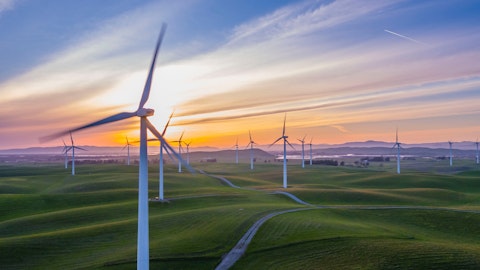Valero Energy Corporation (NYSE:VLO) Q2 2023 Earnings Call Transcript July 27, 2023
Valero Energy Corporation beats earnings expectations. Reported EPS is $11.36, expectations were $5.08.
Operator: Greetings, and welcome to the Valero Energy Corp. Second Quarter 2023 Earnings Call. At this time, all participants are in a listen-only mode. A brief question-and-answer session will follow the formal presentation. [Operator Instructions] As a reminder, this conference is being recorded. It is now my pleasure to introduce your host, Homer Bhullar, Vice President, Investor Relations and Finance. Thank you. Please go ahead.
Homer Bhullar: Good morning, everyone, and welcome to Valero Energy Corporation’s second quarter 2023 earnings conference call. With me today are Lane Riggs, our CEO and President; Jason Fraser, our Executive Vice President and CFO; Gary Simmons, our Executive Vice President and COO; and several other members of Valero’s senior management team. If you have not received the earnings release and would like a copy, you can find one on our website at investorvalero.com. Also attached to the earnings release are tables that provide additional financial information on our business segments and reconciliations and disclosures for adjusted financial metrics mentioned on this call. If you have any questions after reviewing these tables, please feel free to contact our Investor Relations team after the call.
I would now like to direct your attention to the forward-looking statement disclaimer contained in the press release. In summary, it says that statements in the press release and on this conference call that state the company’s or management’s expectations or predictions of the future are forward-looking statements intended to be covered by the Safe Harbor provisions under federal securities laws. There are many factors that could cause actual results to differ from our expectations, including those we’ve described in our earnings release and filings with the SEC. Now I’ll turn the call over to Lane for opening remarks.
Lane Riggs: Thank you, Homer, and good morning, everyone. Before we discuss quarterly results, I want to thank Joe Gorder for everything he’s done to build upon Valero’s 43-year history. Joe steered a repositioning of our strategy and the commitment to shareholder returns through capital discipline, innovation and strong execution. I’m grateful for his leadership and proud of what Valero has accomplished, and I’m honored to build on that foundation as we continue to advance our position as a leading manufacturer of liquid transportation fuels. Moving on to quarterly results. We are pleased to report solid financial results in the second quarter, underpinned by our strong execution across all of our business segments. Our refineries ran well with throughput capacity utilization of 94% as refinery margins were supported by continued tight product supply and demand balances.
Product demand was strong with our US wholesale system setting a sales record of over one million barrels per day in May and June. We also had a positive contribution from the Port Arthur Coker project, which was started up in early April and is operating well and at full capacity. The new coker has increased the refinery’s throughput capacity and enhance its ability to process incremental volumes of heavy crude and residual feedstocks. Our Renewable Diesel segment set records for operating income and sales volumes in the second quarter, driven by incremental production volumes from Diamond Green Diesel, Port Arthur. The Diamond Green Diesel sustainable aviation fuel project at Port Arthur is progressing on schedule. Plan is expected to have the ability to upgrade 50% of the current 470 million gallon annual renewable diesel production capacity through Sustainable Aviation Fuel or SAF, is expected to be complete in 2025 and have estimated a cost of $315 million, with half of that attributable to Valero.
With the completion of this project, DGD is expected to become one of the largest manufacturers of SAF in the world. These projects expand our long-term competitive advantage, and I want to commend our projects and operations team for their dedication and execution. We also continue to evaluate other opportunities while maintaining capital discipline and honoring our commitment that all projects meet a minimum return threshold. On the financial side, we returned 53% of the adjusted net cash provided by operating activities to shareholders through dividends and share repurchases in the second quarter. And we ended the second quarter with a net debt to capitalization ratio of 18%. Looking ahead, we expect low global light product inventories and tight product supply-and-demand balances to continue to support refining fundamentals.

Copyright: Elnur / 123RF Stock Photo
Global demand for transportation fuels has recovered substantially with gasoline and diesel demand now comparable to pre-pandemic levels and jet fuel demand continues to increase steadily. In closing, we remain committed to the core strategy that has been in place under Joe’s leadership for nearly a decade. Our focus on operational excellence, capital discipline and honoring our commitment to shareholder returns have served us well and will continue to anchor our strategy going forward. So Homer, with that, I’ll hand the call back to you.
Homer Bhullar: Thanks, Lane. For the second quarter of 2023, net income attributable to Valero stockholders was $1.9 billion or $5.40 per share compared to $4.7 billion or $11.57 per share for the second quarter of 2022. Second quarter 2022 adjusted net income attributable to Valero stockholders was $4.6 billion or $11.36 per share. . The Refining segment reported $2.4 billion of operating income for the second quarter of 2023 compared to $6.2 billion for the second quarter of 2022. Adjusted operating income was $6.1 billion for the second quarter of 2022. Refining throughput volumes in the second quarter of 2023 averaged 3 million barrels per day, implying a throughput capacity utilization of 94%. Refining cash operating expenses were $4.46 per barrel in the second quarter of 2023, lower than guidance of $4.60, primarily attributed to lower-than-expected natural gas prices.
Renewable Diesel segment operating income was $440 million for the second quarter of 2023 compared to $15 2 million for the second quarter of 2022. Renewable Diesel sales volumes averaged 4.4 million gallons per day in the second quarter of 2023, which was 2.2 million gallons per day higher than the second quarter of 2022. The higher sales volumes in the second quarter of 2023 were due to the impact of additional volumes from the start-up of the DGD Port Arthur plant in the fourth quarter of 2022. The Ethanol segment reported $127 million of operating income for the second quarter of 2023 compared to $101 million for the second quarter of 2022. Adjusted operating income for the second quarter of 2022 was $79 million. Ethanol production volumes averaged 4.4 million gallons per day in the second quarter of 2023 which was 582,000 gallons per day higher than the second quarter of 2022.
For the second quarter of 2023, G&A expenses were $209 million and net interest expense was $148 million. Depreciation and amortization expense was $669 million and income tax expense was $595 million for the second quarter of 2023. The effective tax rate was 22%. Net cash provided by operating activities was $1.5 billion in the second quarter of 2023. Excluding the unfavorable change in working capital of $1.2 billion in the second quarter, and the other joint venture member share of DGD’s net cash provided by operating activities, excluding changes in its working capital, adjusted net cash provided by operating activities was $2.5 billion. Regarding investing activities, we made $458 million of capital investments in the second quarter of 2023, of which $382 million was for sustaining the business, including costs for turnarounds, catalysts and regulatory compliance; and $76 million was for growing the business.
Excluding capital investments attributable to the other joint venture members share of DGD, capital investments attributable to Valero were $433 million in the second quarter of 2023. Moving to financing activities. We returned over $1.3 billion to our stockholders in the second quarter of 2023, of which $367 million was paid as dividends and $951 million was for the purchase of approximately 8.4 million shares of common stock resulting in a payout ratio of 53% of adjusted net cash provided by operating activities. Last week, we announced a quarterly cash dividend on common stock of $1.02 per share payable on September 5, 2023, to holders of record at the close of business on August 3, 2023. With respect to our balance sheet, we ended the quarter with $9 billion of total debt, $2.3 billion of finance lease obligations and $5.1 billion of cash and cash equivalents.
The debt-to-capitalization ratio net of cash and cash equivalents was 18% as of June 30, 2023. And we ended the quarter well capitalized with $5.4 billion of available liquidity, excluding cash. Turning to guidance. We expect capital investments attributable to Valero for 2023 to be approximately $2 billion, which includes expenditures for turnarounds, catalysts and joint venture investments. About $1.5 billion of that is allocated to sustaining the business and the balance to growth. For modeling our third quarter operations, we expect Refining throughput volumes to fall within the following ranges: Gulf Coast at 1.77 million to 1.82 million barrels per day; Mid Continent at 450,000 to 470,000 barrels per day; West Coast at 240,000 to 260,000 barrels per day; and North Atlantic at 435,000 to 455,000 barrels per day.
We expect Refining cash operating expenses in the third quarter to be approximately $4.70 per barrel. With respect to the Renewable Diesel segment, we expect sales volumes to be approximately 1.2 billion gallons in 2023. Operating expenses in 2023 should be $0.49 per gallon, which includes $0.19 per gallon for noncash costs such as depreciation and amortization. Our Ethanol segment is expected to produce 4.4 million gallons per day in the third quarter. Operating expenses should average $0.39 per gallon, which includes $0.05 per gallon for noncash costs such as depreciation and amortization. For the third quarter, net interest expense should be about $145 million, and total depreciation and amortization expense should be approximately $690 million.
For 2023, we expect G&A expenses, excluding corporate depreciation, to be approximately $925 million. That concludes our opening remarks. Before we open the call
See also 10 Best Small Cap Electric Vehicle Stocks to Buy and 11 Best Logistics Stocks to Buy.
Q&A Session
Follow Valero Energy Corp (NYSE:VLO)
Follow Valero Energy Corp (NYSE:VLO)
Operator: [Operator Instructions] Today’s first question is coming from Manav Gupta of UBS.
Manav Gupta: Guys, I just want to quickly start with and congratulate Gary for the promotion and the new rule and all our best wishes are with you. The first question I have for you is that when we look at DGD, you guys have a track record of bringing projects online before time. So is there a possibility a year down the line, you could take a look at it and say, we would like to have similar upgrades possible at DGD 1 and 2 to make more sustainable aviation fuel on a go-forward basis?
Eric Fisher: Yes. Manav, this is Eric. Obviously, that is a possibility because those are cookie-cutter units, and we could do the exact same project at St. Charles that we are currently underway at Port Arthur. It’s too early to talk about any numbers or commitment, but yes, that’s definitely something we’re looking at and something that we could do.
Manav Gupta: Good. The second question here is the DOE data is telling us whatever it is, and there are obviously some concerns around demand out there, but the cracks are telling us a completely different story. The cracks are telling us the demand for products is remarkably strong. So just wondered if you could highlight some of the — what you’re seeing in terms of demand in various regions?
Gary Simmons: Yes, Manav, this is Gary. We do believe that the DOE is understating gasoline demand. But even their data is showing on a 4-week average basis gasoline demand up about 3%. But if you look at our numbers, of course, Lane mentioned we had record volumes in both May and June of over 1 million barrels a day. We’re seeing gasoline sales in our system up 14% year-over-year, up 22% from pre-pandemic levels. Gasoline inventory year-over-year is down 7.5 million barrels. So it’s trending at the low end of the 5-year average range. Typically, this time of year, you have an open arb to ship barrels from Europe into the United States. But with inventory low in Europe, that arb is closed, which is hindering imports, and we see strong export demand from the U.S. Gulf Coast into South America.
So the fundamentals around gasoline look very good. Diesel inventory is up 6 million barrels, but continues to trend below the 5-year average range. Diesel inventory is flat, where historically, this time of year, we start to see diesel building. Again, while the DOE reflects weaker diesel demand year-over-year, it looks like the weekly data is continually being revised up. So although we certainly that we had a weaker heating oil season, diesel demand looks fairly similar to last year. So we moved forward a lot of encouraging signs around diesel where we saw weaker tonnage index in the second quarter, the June data reflects that the tonnage index is picking back up. We’ll start to see more agricultural demand as we get into harvest season and more heating oil demand as we get into colder weather.
Continue to see very good export demand from the US Gulf Coast into South America. Some of that has fallen off as we’ve replaced some supply with Russian barrels, but largely been replaced with more export demand from the US Gulf Coast into Europe. Jet demand also picking up, and had a positive impact on overall distillate supply-demand balances, so the distillate demand looks up 10% year-over-year. It looks pretty strong. All the airlines are reporting very strong demand. Jet trading at a $0.10 per gallon premium in the US Gulf Coast on a rent-adjusted basis today. So, yes, the fundamentals look very, very good.




